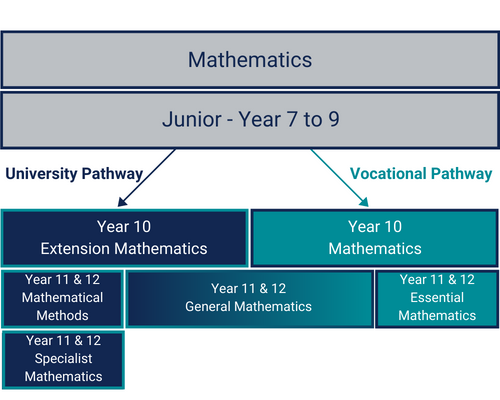Prerequisites
A minimum B result for Year 10 Preparatory Mathematical Methods.
Corequisites
N/A
Subject Description
Mathematical Methods enables students to see the connections between mathematics and other areas of the curriculum and apply their mathematical skills to real-world problems, becoming critical thinkers, innovators and problem-solvers.
Students learn topics that are developed systematically, with increasing levels of sophistication, complexity and connection, and build on algebra, functions and their graphs, and probability from the P–10 Australian Curriculum.
Calculus is essential for developing an understanding of the physical world. Statistics is used to describe and analyse phenomena involving uncertainty and variation. Both are the basis for developing effective models of the world and solving complex and abstract mathematical problems.
Weekly workload in hours
4+ hours
Structure
Algebra, statistics and functions
| Calculus and further functions
| Further calculus
| Further functions and statistics
|
Arithmetic and geometric sequences and series 1
| Exponential functions 2
| The logarithmic function 2
| Further differentiation and applications 3
|
Functions and graphs
| The logarithmic function 1
| Further differentiation and applications 2
| Trigonometric functions 2
|
Counting and probability
| Trigonometric functions 1
| Integrals
| Discrete random variables 2
|
Exponential functions 1
| Introduction to differential calculus
| | Continuous random variables and the normal distribution
|
Arithmetic and geometric sequences | Further differentiation and applications 1
|
| Interval estimates for proportions |
| Discrete random variables 1
|
| |
Assessment
In Units 1 and 2 students complete 4 formative assessments with an overall subject result (A-E). In Units 3 and 4 students complete four summative assessments. The results from each of the assessments are added together to provide a subject score out of 100. Students will also receive an overall subject result (A–E).
Summative assessment
Summative internal assessment 1 (IA1): Problem-solving and modelling task | 20% | Summative internal assessment 3 (IA3): Examination | 15% |
Summative internal assessment 2 (IA2): Examination | 15% |
Summative external assessment (EA): 50%
Examination |
